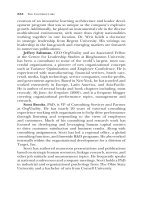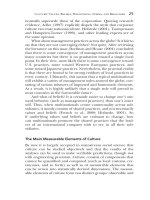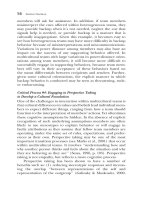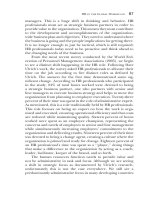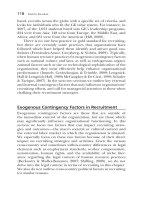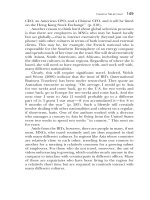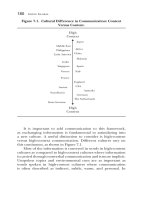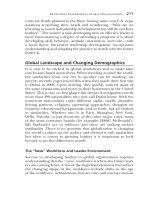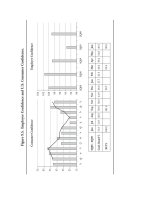Going Global Practical Applications and Recommendations for HR and OD Professionals in the Global Workplace J-B SIOP Professional Practice Series by Kyle Lundby, Jeffrey Jolton and Allen I. Kraut_2 doc
Bạn đang xem bản rút gọn của tài liệu. Xem và tải ngay bản đầy đủ của tài liệu tại đây (507.13 KB, 28 trang )
The Contributors xxvii
the Academy of Management. She is currently president of the
International Association for Conflict Management.
Mario Di Loreto is responsible for Group Human Capital and
Human Capital Strategy of Barilla worldwide, providing guidance
to HC corporate functions and HC Business Partners. Prior to
this, Mario was the human resources director for Mediterranean
Region at Starwood Hotels & Resorts for about ten years, where
he was part of Divisional HR Board and several innovation project
management teams at the corporate level. He started his career
in human resources with two airline companies, Alitalia and Air
One (where he was part of the start-up of the company). Mario
graduated in philosophy and earned a PhD in philosophy of
science and history of ideas. He also earned an MBA at Bocconi
University in Milan. Mario has been the author of several books
and articles in both disciplines, management and philosophy.
Mukta Kulkarni is an assistant professor and Young Faculty
Research Chair at the Indian Institute of Management Bangalore.
She received her PhD in organization and management studies
from the University of Texas at San Antonio. Her research articles
have appeared in Leadership Quarterly, Human Resource Management,
and Academy of Management Journal. Her coauthored paper on
radical change won the Academy of Management Journal best
paper award in 2007. She has also worked as a human resource
generalistatLehmanBrothers.
Mathian (Mat) Osicki currently works for IBM as a Global
HR Partner. She received her bachelor’s degree from the Uni-
versity of Calgary in Canada and then her PhD degree in
industrial/organizational psychology from the University of Tulsa
in Oklahoma. She joined IBM as a researcher in the Global Work-
force Research area of HR. A few years later she lived in India
while conducting a workplace climate study for IBM. Upon her
return she worked within the Executive Compensation area of HR
before starting her current generalist role. Mat was also an adjunct
professor at New York University, teaching graduate-level courses
for a couple of years. Mat has presented at SIOP conferences on
a variety of corporate topics.
Tim Carey is an industrial and organizational psychologist
with over 10 years’ experience, including extensive corporate
expertise in leadership assessment and development. Currently,
xxviii The Contributors
he is a professional consultant with the Psychology Department
at the Chinese University of Hong Kong, where he lectures at the
graduate and undergraduate levels in psychology and trains and
places undergraduate and graduate students in various compa-
nies across Hong Kong and Shanghai for internships. In addition,
he is active in delivering assessment and development services
around the region for managers and executives. Tim served with
a global consulting firm for four years before joining the uni-
versity. With that organization, his last position was director of
consulting services for Greater China. He has delivered consult-
ing services across the Asia Pacific region, as well as in Europe
and the Middle East, for clients in many industries, including
Shell, the Mandarin Oriental Hotel group, Credit Suisse, EADS,
CLP, Walmart, and HP.
A permanent resident of Hong Kong, Tim has lived in the
city for eight years. He completed his MA and PhD in industrial/
organizational psychology at the University of South Florida, in
the United States.
David Herst is an instructor at Florida Atlantic University in
sunny Boca Raton, Florida. He has published on work and family
conflict, theintricacies ofonline instruction,and cross-cultural test
construction. Dr. Herst teaches organizational behavior, human
resource management, and cross-cultural communication and
negotiation at both the graduate and undergraduate levels. Prior
to becoming an academic, he worked for TMP Worldwide (now
Monster.com) as a codeveloper of a career management system,
which included measures of personality, value systems, and orga-
nizational culture preferences. Dr. Herst has also worked as an
assessor for a large energy company’s executives, consulted with
numerous local human resources offices to create everything
from resume tracking systems to full bonus systems, and while in
graduate school worked on the validation of the Armed Services
Vocational Aptitude Battery.
Dr. Herst is currently working on a wide range of research
topics including cross-cultural differences in test construction,
the validity of manipulation checks, and various collaborative
measures with individuals from other departments. He holds a
PhD in industrial/organizational psychology from the University
of South Florida.
The Contributors xxix
Wynne Chan is currently working with Standard Chartered
Bank in Hong Kong. She is a graduate of the industrial-
organizational psychology master’s program of the Chinese
University of Hong Kong (CUHK) and earned her bachelor’s
degree with a double major in economics and psychology from
the University of British Columbia, Canada. Having studied and
worked in both Canada and HongKong, Wynne hasgained a cross-
cultural perspective of the business world from several regions.
During her two years of study at the CUHK, Wynne carried
out consultancy projects and training workshops for different
organizations in Hong Kong and China, including Hutchison
Port (China), the Social Welfare Department of Hong Kong,
Eurogroup Far East Limited,, and the Nansha Grand Hotel.
Mary Mannion Plunkett, PhD, is the global head of People
and Organizational Development for Heineken International,
responsible for talent management, leadership development, per-
formance management, and organizational capability. Previously,
Mary was the senior vice president for Lehman Brothers, respon-
sible for Talent Management in Europe and the Middle East,
and vice president Executive Development, for BP Plc. She has
more than 18 years of experience in the field of leadership
and organization development, including roles with the Boeing
Company, Ernst & Young LLP, and McDonnell Douglas Air-
craft Company. Mary also served as an adjunct professor in the
Organizational Behavior Department at Seattle Pacific University.
Dr. Tommy Weir serves as vice president of leadership solu-
tions at Kenexa. He is a thought leader specializing in strategic
leadership for fast-growth and emerging markets, a gifted speaker,
and author of The CEO Shift —a book that explores the new global
business environment and challenges corporate leaders to shift
their practices in order to survive in the new economy. Dr. Weir
has a rich history of leadership development experience and has
held top management and teaching positions throughout his
career. He has taught organizational leadership and management
courses at the graduate and university level, and consulted with
global organizations, including many Fortune 100 companies. His
latest position was as the head of learning and development at
Nakheel (in Dubai), where he was named the Middle East’s HR
Professional of the Year. While there, Dr. Weir spearheaded the
xxx The Contributors
creation of an innovative learning architecture and leader devel-
opment program that was as unique as the company’s explosive
growth. Additionally, he played an instrumental role in the diverse
multicultural environment, with more than eighty nationalities
working together in one location. Dr. Weir holds a doctorate
in strategic leadership from Regent University. His writings on
leadership in the fast-growth and emerging markets are featured
in numerous publications.
Jeffrey Saltzman, CEO OrgVitality and an Associated Fellow
at the Center for Leadership Studies at Binghamton University,
has been a consultant to some of the world’s largest, most suc-
cessful organizations, a pioneer of new organizational concepts
such as Variance Optimization and Employee Confidence. He is
experienced with manufacturing, financial services, heath care,
retail, media, high technology, service companies, not-for-profits,
and government agencies. Based in New York, he has traveled and
worked extensively in Europe, Latin America, and Asia-Pacific.
He is author of several books and book chapters including, most
recently, My Jeans Are Irregulars (2009), and is a frequent blogger
covering organizational performance topics, management and
research.
Scott Brooks, PhD, is VP of Consulting Services and Partner
at OrgVitality. He has nearly 20 years of external consulting
experience working with organizations to help drive performance
through listening and responding to the views of employees
and customers. Much of his consulting and research work has
focused on developing and leveraging human capital metrics
to drive customer satisfaction and business results. Along with
consulting assignments, Scott has led a regional office, a global
consulting function, and firmwide R&D programs. He also worked
internally within the organizational development for a division of
Target, Inc.
Scott has authored numerous presentations and publications
based on strategic human resources, linkage research, surveys, and
other job attitude and measurement topics. He frequently speaks
at national conferences and company meetings. Scott holds a PhD
in industrial and organizational psychology from The Ohio State
University and a bachelor of arts from Cornell University.
The Contributors xxxi
Jessica L. Wildman is a doctoral student in the industrial/
organizational psychology program at the University of Central
Florida, where she has been a graduate research associate at
the Institute for Simulation and Training since 2007. She has
been working on a variety of projects related to culture, teams,
and performance. She has published four book chapters and two
peer-reviewed journal articles, and has presented over 10 presenta-
tions or posters at professional conferences. Her current research
interests include multicultural performance, team process and
performance, virtual teams, and interpersonal trust.
Luiz Xavier is a doctoral student in the industrial/
organizational psychology program at the University of Central
Florida. He currently works as a graduate research assistant at
the Institute for Simulation and Training. Xavier received a B.S.
in psychology and M.S. in industrial/organizational psychology
from San Francisco State University. His research interests
include teamwork, training, diversity, and conflict.
Mitchell Tindall is a doctoral student in the industrial/
organizational psychology program at the University of Central
Florida. He is a graduate research assistant at the Institute for
Simulation and Training. There he has been involved in several
research projects related to culture and teams. He received his
M.S. in industrial and organizational psychology from the Univer-
sity of Central Florida. During that time he worked as a contract
consultant in the selection of personnel using both cognitive abil-
ity and personality tests. His current research interests include the
effects of culture on performance of teams, diversity, training, and
motivation.
Paul M. Mastrangelo, PhD, has over 15 years’ experience in
organization development, HR research, and adult education.
As a senior consultant and director of the Analytic Consult-
ing Team for CLC-Genesee, Paul collaborates with leaders from
global companies to evaluate employee perceptions and motiva-
tion. His experiences include designing and analyzing employee
surveys, advising senior executives, developing small and large
change interventions, creating competency-based training, and
building selection instruments. He coauthored the 2008 book
Employee Surveys in Management and has over 25 professional
xxxii The Contributors
publications. Paul earned his doctorate in industrial and orga-
nizational psychology from Ohio University in 1993.
Paula Caligiuri is a professor in the Human Resource Man-
agement Department in the School of Management and Labor
Relations at Rutgers University, where she is the director of the
Center for Human Resource Strategy (CHRS). Paula researches,
publishes, and consults in three primary areas: strategic human
resource management in multinational organizations, global lead-
ership development, and international assignee management. As
an academic, Paula Caligiuri has been recognized as one of the
most prolific authors in the field of international business for
her work in global careers and global leadership development.
Her academic publications include articles in the International Jour-
nal of Human Resource Management, Journal of World Business, Journal
of Applied Psychology, Personnel Psychology,andInternational Journal of
Intercultural Relations.Withafocusonglobalcareers,shehas
coauthored a book with Steven Poelmans, entitled Harmonizing
Work, Family, and Personal Life (Cambridge Press, 2008). Her book
(with Dave Lepak and Jaime Bonache) Global Dimensions of HRM:
Managing the Global Workforce (Wiley) is forthcoming. Paula holds
a PhD from Penn State University in industrial and organizational
psychology.
Thomas Hippler is lecturer in Human Resource Manage-
ment and International Business in the School of Business and
Economics at Swansea University (UK). He holds a PhD in inter-
national human resource management from the University of
Limerick (Ireland). He is a member of the Academy of Man-
agement, Academy of International Business and is serving as a
member of the Editorial Review Board of the Journal of Managerial
Psychology. His research interests are in the area of International
Human Resource Management, particularly international assign-
ments and expatriate management as well as adjustment to
domestic and international job transfers. Dr. Hippler has pub-
lished in the International Journal of Human Resource Management
and has book chapters in New Directions in Expatriate Research and
International Human Resource Management and Expatriate Transfers:
Irish Experiences. Dr. Hippler understands global experiences first-
hand; being a German citizen, he completed his PhD in Ireland
The Contributors xxxiii
and then moved to the United Kingdom, where he currently
resides and works.
Tammy D. Allen is professor of psychology at the University of
South Florida. Tammy’s research centers on individual and orga-
nizational factors that relate to employee career development,
health, and well-being. Specific interests include mentoring rela-
tionships, work-family interactions, career development, organiza-
tional citizenship, and occupational health. Tammy is coauthor of
Designing Workplace Mentoring Programs: An Evidence-Based Approach
and coeditor of The Blackwell Handbook of Mentoring: A Multiple Per-
spectives Approach. She is associate editor for the Journal of Applied
Psychology and the Journal of Occupational Health Psychology. She
currently serves on the executive board of the Society of Industrial
and Organizational Psychology. Tammy is a Fellow of the Society
for Industrial and Organizational Psychology and the American
Psychological Association.
Kristen M. Shockley is a doctoral candidate of indus-
trial/organizational psychology at the University of South Florida.
Her research interests are centered on the intersection of work
and family, with a focus on organizational responses to work-
family conflict, dual-earner couples’ work-family management,
and the relationship of these issues to health outcomes. She has
published her work in the Journal of Vocational Behavior.
Andrew Biga is a manager in the Employee and Organization
Research and Sensing (EORS) HR practice for the Procter &
Gamble Company, headquartered in Cincinnati, Ohio. Andrew
is the owner of P&G’s engagement survey program, delivered
annually to more than 138,000 employees worldwide. In addition,
Andrew is the global leader for P&G’s People Sensing and Analyt-
ics program that delivers systemic research-based talent solutions.
Responsibilities include influencing strategy and communication
for senior leadership. Andrew joined P&G in 2007 and com-
pleted his PhD in industrial/organizational psychology from the
University of South Florida.
PART 1
Practical
Considerations
for HR and OD
Practitioners
Working Across
Geographic-
Cultural
Boundaries:
The Changing
Workplace
CHAPTER 1
Navigating the
Complexities of a
Global Organization
Mariangela Battista, Patricia Pedigo,
and Erica Desrosiers
We live and operate in a global world. A flu outbreak in Mexico
has an impact on fruit pricing in Asia. A mortgage meltdown
in the United States has an impact on world financial markets.
Globalization brings with it a web of interconnectedness that
didnotexistpreviously,oratleastnottotheextentthatit
does now. Organizations today are affected by nearly everything
that transpires around the world, not just the local markets or
communities in which they operate. Although global supply chains
have created huge market efficiencies, they have also brought
vulnerabilities. Disruption to a key node in the supply chain can
cause dramatic and unpredictable turbulence in the whole system.
The financial and economic events of 2008 have demonstrated
how tightly intertwined globalization has made the world and its
systems.
Globalization has also had significant implications for organi-
zational processes, systems, and operations. Years ago, when most
of an organization’s employees were generally in the same country
and most of their business was conducted in their home country,
life was simple. There was no need to worry about cultural differ-
ences, language differences, time zones, or local relevance. That
luxury has long since disappeared and the reality of organizations
1
2 Going Global
today is that operating globally is a more complex undertaking
than one might have expected. Becoming a truly global operator
entails far more than simply selling the same thing in more places,
hiring the same people in more locations, or just pushing out the
same processes and procedures around the world. Operating in
this mind-set is likely a recipe for failure. Globalization requires
a business model that is adaptable and employees who openly
welcome new ways of thinking.
Human Resources professionals provide value to their orga-
nization by successfully navigating the complexities of a global
organization, and in doing so they bring the business strategy to
life for their employees. They understand the human dynamics
of operating in different cultures and how to facilitate the orga-
nization’s success. HR professionals are tasked with the strategy
and execution of all people-related processes and initiatives in
the organization. In global organizations, that role takes on the
additional complexity of operating across cultural and language
barriers, operational differences, local relevance and appropri-
ateness, time zones, and peak business and holiday schedules,
just to name a few. This chapter will highlight examples of
situations and contexts often encountered by HR practitioners
operating within global organizations that may present chal-
lenges and offers specific suggestions for how to navigate in
these global waters.
What Does It Mean to Be Global?
Although we live in a globalized world, there are still challenges
in defining a global organization. Think of global organiza-
tions as snowflakes—no two look exactly alike. Organizations
can operate under four distinct stages of globalization (Hewitt,
2009)—multinational, international, transitioning to global, and
global. Multinational organizations have cross-border operations
that are primarily decentralized and autonomous. International
organizations have a headquarters that retains some decision-
making control but the organization is still largely decentralized.
Organizations transitioning to global are taking concrete steps to
develop worldwide business strategies and policies (note that
most organizations identify themselves as transitioning). Some
Navigating the Complexities of a Global Organization 3
organizations are truly global in that they develop strategies and
policies on a worldwide basis and share resources across borders.
Even for domestically focused organizations, globalization is just
as salient, given relationships with suppliers, investors, and even
nonnative employees.
What are the implications of those differences in global-
ization? In more decentralized organizations operating in the
earlier stages of globalization, systems and processes are largely
independent and disconnected. There are certainly advantages
of this, in that these systems and processes can be tailored to
theuniqueneedsofthelocaloperationandareofteneasier
to create, execute, and adapt when local conditions warrant.
A local operation can often be more nimble when not restricted
to the longer and more effortful design and implementation
of a global process (Sirkin, Hemerling, & Bhattacharya, 2008).
If everyone is working independently and autonomously, how-
ever, the organization is not poised to leverage the best practices
created and implemented within their very own organization.
In addition, there is a significant amount of duplicated and
wasted effort, as everyone works to re-create the wheel over and
over again.
Understanding and leveraging organizational-level insights is
also difficult. For example, assessing and securing enterprise-wide
talent pools becomes much more of a challenge when there is little
consistency in how things are measured and what information is
tracked or shared. In organizations that are further along on the
‘‘global’’ continuum, everything often takes longer because of
the required alignment and integration needed to be successful,
but the synergies that are created are quite beneficial to the
organization in the longer term. Getting to that point, however,
requires a significant amount of work.
The Inherent Complexity of Globalization
The people in and related to organizations—whether employees,
shareholders, or customers—bring with them cultural, geograph-
ical, geopolitical, and language attributes. How these different
and varying attributes are managed and leveraged across con-
stituent groups within the organization has an impact on how well
4 Going Global
organizations are run and ultimately on the organization’s suc-
cess. Cultures vary, even within countries, and certainly within and
across continents. Understanding the complexity both within
regions and on a global scale is especially important based on
the significant increase in regional and global trade since 1959
(Kim & Shin, 2002). In the geographically structured organiza-
tion, where divisions are represented by geography or country, as
opposed to product or brand, understanding cultural complexi-
ties is critical to business success. For example, leaders responsible
for an Asia Pacific division must understand the cultural dif-
ferences that exist between Taiwan and New Zealand, or Japan
and China, and modify their products and marketing appropri-
ately. This is similar for a North American division—one cannot
assume that what works in the United States will work also in
Canada.
Cultures
These cultural implications apply to customers aswell as to employ-
ees. In the late 1990s Walmart decided to open stores in Germany
as part of their strategic growth initiative. Walmart purchased
some small German retail chains and had a successful Walmart
executive from Bentonville, Arkansas, run the operations. Nine
years and one billion dollars later, Walmart pulledout of Germany.
Their planned expansion was a total failure (Solomon & Schell,
2009). Walmart made a then common mistake by assuming that
what worked in the United States would work everywhere. They
expected that German shoppers would react the same way that
American shoppers do to the greeters at the door and the clerks
bagging their purchases at checkout. However, the German cul-
ture is more hierarchical. Shoppers were not as comfortable
receiving the ‘‘How are you?’’ greeting at the door, nor were
the German Walmart employees comfortable giving the greeting.
German employees also participated in daily morning cheering
sessions led by store managers, a practice in all U.S. stores.
Corporate culture and national culture clashed. The successful
Bentonville executive did not even speak German and required his
management team to speak English. Walmart exported its entire
U.S. corporate culture without appreciating the differences—and
suffered significant consequences.
Navigating the Complexities of a Global Organization 5
Governments and Regulations
Cultures are shaped by geography, language, politics, and lead-
ership. Italy has seen over 60 governments in power since World
War II. Changing governments and administrations imply chang-
ing laws and regulations. For example, if you are a global
organization with operations in Italy, the changing government
may affect how your business operates and ultimately your very
success. Western organizations did very little business in Asian
markets a generation ago. As governments lifted trade barri-
ers, organizations recognized opportunities for new markets. For
example, Pepsi was one of the first brands in Vietnam as soon as
the trade barrier was lifted. Navigating geopolitical relationships
can also be a challenge and can often influence how geographic
organization structures are established. Do you put China and
Taiwan in the same geography? How do you manage the Middle
East? These political relationships spill over into how the organi-
zation is structured and even how products are transported and
services provided.
In order to conduct business in a particular market, more
and more global companies are relocating key operations and
production facilities to high-growth countries. In addition to
providing a significant local presence, this often enables the
company to more effectively compete for local governmental
contracts.
Languages
One cannot underestimate the power of language. In many global
organizations, English is the official or de facto language of the
business. Yet, if an organization wants to engage the hearts and
minds of its employees, then communication in the native tongue
is essential to ensure effectiveness.
We know that the way an organization communicates has huge
implications for the engagement of the employees and the success
of the organization (Welch & Welch, 2008). Literal translations
often do not communicate the correct message or with the pas-
sion needed to motivate employees. Conducting translations and
having in-country employees review the translation often works to
ensure that the right message is being communicated. Even that
may not be enough, though. Just because a message is translated
6 Going Global
accurately,thecontentofthemessageitselfmaybeperceived
as headquarters-centric. This may serve to alienate business units
rather than bring them closer together as global units; they may
feel that ‘‘corporate doesn’t ‘get us.’’’
Other examples can be quite basic in their headquarters-
centric style. One of the authors worked with senior HR leadership
to create a global communication regarding an upcoming global
survey, noted as coming ‘‘later this summer.’’ That was fine for
employees who would actually be in the summer months but for
some regions, it would be winter. Such missteps are confusing at
best, and divisive at worst, implying a very headquarters-centric
mind-set and attitude. For many HR practitioners, it usually takes
at least one or two such missteps before they start to operate in a
truly global mind-set, more appropriate for the organization.
Organizational Structure
As described earlier in the various stages of globalization, orga-
nizations can have very centralized or decentralized operations.
In a centralized organization there are typically centers of excel-
lence which exist in a headquarters-type environment where they
are responsible for the design and execution of programs and
initiatives implemented in the field business units. Centralized
organizations create standards of operation and performance to
ensure consistency in global deployment. For example, the Disney
experience is expected to be the same whether it is in Orlando
or Paris. The organization is dependent upon the highest-quality
customer experience for business success. In decentralized organi-
zations, every business unit operates independently with its own set
of processes and initiatives. For a business whose success is depen-
dent upon local adaptability and flexibility, this model enables
rapid response to changes in local markets. Each approach has
its advantages and disadvantages depending upon the business
model and market requirements. In at least one large global
company we know of, and likely many more, both models are
operating, centralizing some functions while decentralizing some
operations. HR can and should help organizations match the right
design with the business model and strategy.
To add to the complexity, many large, global organizations are
matrixed in structure. There are product or brand lines overlaying
geographies. If leaders think that managing multiple product lines
Navigating the Complexities of a Global Organization 7
is a challenge, it becomes exponentially more complex when prod-
uct lines become matrixed with geographies. Key concern areas
of staffing, resources, and customer coverage require ongoing
negotiation between the local geography and the brand and prod-
ucts to ensure the right balance. Although global companies go
to great lengths to interlock these requirements as part of their
annual planning processes, modifications and adjustments are
often needed during the year. Helping employees and leaders
navigate the matrix structure is an important contribution that
HR can make to overall organizational effectiveness, especially
when employees join through acquisitions or external hiring.
Successfully managed global organizations have a clear under-
standing of how they work. As mentioned earlier regarding the
continuum of definitions of globalization many companies under-
stand which key business models are the sources of revenue.
Even within the same industry, we see different operating or busi-
ness models that drive how people interact and bring value into
the organization. For example, PricewaterhouseCoopers defines
itself as a network of partners and limits its top-down influence.
Accenture sees itself as is a matrixed organization that is ulti-
mately project-centered with the focus on what is right for the
client project. PepsiCo and Starwood Hotels & Resorts are both
collectives of clearly defined brands with a common set of core
organizational values.Through its structure, each organization has
defined for themselves how headquarters (HQ) and field are con-
nected and how they work together to be successful. IBM is also a
highly matrixed organization with the integration of products and
services to meet customer needs as the core of its business success.
Headquarters versus the Field
For centralized organizations with centers of excellence, it is
critical that input from the divisions or the field be solicited on a
regular basis. It is a grand mistake to design a program or make
decisions in headquarters without ‘‘vetting it’’ through the global
divisions so that issues of culture, language, and operational reality
are addressed and a successful implementation can be ensured.
Nothing kills an initiative faster than saying it is a mandate from
headquarters.
Even more than soliciting input from or vetting plans with
the field, the best results come from true partnerships between
8 Going Global
the headquarters center and business partners in the field. The
field partners are the ones with their ‘‘finger on the pulse’’ of
the organization and can provide valuable input at all phases. Not
only does a partnership result in a better end product or process,
but there is a sense of ownership and buy-in that comes from this
collaborative effort. This regular dialogue secures critical local
ownership and sponsorship of the initiatives and their implemen-
tation. For instance, some organizations create global councils or
task forces that meet regularly either for the duration of a discrete
project or on a more extended basis to ensure true global rep-
resentation and partnerships. Business and field representatives
that participate are able to share not only how things should work,
but also how they really are working, and what needs to change
and how.
Centers of excellence should be pragmatic in approach. The
reality is that programs and initiatives always seem to take much
longer to implement than a project plan would suggest. Just
because a decision is made and leaders are in agreement that an
initiative is the right course of action does not mean that exe-
cution is as smooth and flawless as envisioned. Behavior change
takes time. New initiatives and processes take time to become
inculcated into the organizational culture, and new behaviors and
expectations take time and effort to learn. This becomes expo-
nentially more complicated when one considers issues of culture,
language, and so on, not to mention the time and effort required
for a cascaded rollout, communications strategy and plan, and
possibly training for local HR, managers, and employees.
Centers of excellence (headquarters) should not assume that
just because an initiative has launched that it is actually operating
as it should. Some anecdotal research suggests that it takes three
years, or three cycles, for the new initiative to take hold. Ironically,
just as processes are taking hold out in the field, leaders in head-
quarters believe it is time to update and refresh or reengineer
the process. Though there may be a business-driven need for the
change, sometimes for the good of the organization it is better to
keep the process consistent longer to ensure the business value
is returned. Any type of change becomes a change-management
issue facing even more complexity associated with culture, lan-
guage, and local support. Some initiatives may need a longer
Navigating the Complexities of a Global Organization 9
shelf life than organizational development (OD) practitioners are
willing to give.
Although eventual change may be inevitable, it is also a
‘‘must-do’’ for HQ to remember that employee consumers of
HR processes do not have a singular focus on all things HR.
They’re busy and often overwhelmed with the content of their
own jobs, of which HR process plays but a small part. It is easy
to forget in HQ or center-based jobs that employees in the field
need additional communication, explanation, and context to
keep everything straight. How does everything fit together? Why
am I doing this? What do I do with this? Why are we changing
things again? HQ practitioners in global organizations often
have significant distance between themselves and the employees
that are ultimately the consumers of their goods, so the impor-
tance of a communications strategy and a set of well-designed and
field-tested tools should not be underestimated.
Having a close connection and working relationship between
the headquarters center of excellence and the field is critical
for organizational success. There must be constant dialogue and
feedback from the field so that the organization is balancing global
organizational needs with local field needs. Global programs
and initiatives must be designed with the field in mind and,
given the variety of countries, cultures, languages, skill levels,
and so forth, simplicity and ease of use are nonnegotiable design
elements. This can be a challenge when the center of excellence
is designing something perhaps ten steps removed from where
they actually sit. For example, if the designer sits in the western
United States, and the end user sits in Dubai, then there has to
be some input from the employee in Dubai to secure effective
implementation. If a program cannot be easily implemented then
it is often deemed too complicated by the end user and chances of
successful implementation are reduced. Practitioners can address
this issue by conducting the appropriate focus groups, field testing,
or pilot testing. Program execution without adequate field input
and testing will likely fail in deployment.
The key for organizations and practitioners is to walk the
fine line between designing the framework with instructions to
implement and customize locally and trying to create consistent,
global standards of excellence. Depending on the business model
10 Going Global
and sources of value to the company, organizations might be
better served by erring on the side of encouraging local tailoring
within defined boundaries to ensure that the program makes
business sense at the field or local level.
Organizational Values
Most organizations have vision and values that define their organi-
zational culture. Vision and values provide a common framework
across the organization. They communicate what the organiza-
tion stands for and how employees should conduct business and
interact with one another and withcustomers.Theysetthetone
for behavioral and performance expectations. Reward systems are
based upon these values.
Many of these values espouse socially desirable behaviors, such
as ‘‘treat others with respect and dignity,’’ ‘‘the customer is always
first,’’ ‘‘value teamwork and collaboration.’’ Almost no one would
argue against these values.
Yet how organizational values are defined and interpreted may
be a source of confusion that can lead to conflict. How do orga-
nizational values and national or ethnic values coexist? Although
socially desirable, organizational values are not necessarily fully
in line with national or ethnic values (Nelson & Gopalan, 2003).
There may be some overlap, especially in the area of personal
behavior toward other employees, but there are also some differ-
ences. Tensions and conflicts can arise between the two if they
are too divergent. For example, ‘‘treat others with respect and
dignity’’ seems pretty innocuous. However, ethnically, it may be
interpreted quite differently. In Asian cultures ‘‘treating others
with respect’’ may be interpreted to mean that feedback is kept
rather mundane and to a minimum, whereas in Western cul-
tures ‘‘treating others with respect’’ could be interpreted as the
opportunity to provide every possible bit of detailed feedback.
As reward systems are based on organizational values, organiza-
tions then must take steps to ensure that there is consistency in
communicating and rewarding expected behaviors.
Recently one of the authors experienced the conflict of orga-
nizational versus national culture over including a question on
the global engagement survey regarding a willingness to challenge
a superior when faced with a values issue. Though intended to
Navigating the Complexities of a Global Organization 11
address issues of integrity and candor, there were cultural impli-
cations to a question like this. In some cultures, employees would
never think to challenge a superior; it is just not done. How-
ever, in order to create and maintain an ethical organizational
culture the company’s employees are encouraged to challenge
others, especially at a higher level. From a compliance standpoint
it is important to ask questions like this, but care is needed in
the interpretation of the results, keeping in mind the biases of
national culture.
Values tend to be identified and set at the top of the orga-
nization. Senior management has a role in defining what the
organization stands for. Sometimes these values come from an
organization’s founder and sometimes they are defined by current
management. If the organization is reexamining and redefining
their values as a result of a new business strategy or leadership
team, this is a great opportunity to get employee perspective and
input—especially global input. IBM did this several years ago with
their ‘‘value jams’’ initiative. The new CEO, Sam Palmisano, and
the senior leadership team held an online, interactive dialogue
with all IBM employees to identify and select the appropriate
values for the ‘‘new’’ IBM (Hempel, 2006). The ‘‘values jam’’
ensuredthatthenewIBMvalueswouldbeembracedbyall
employees worldwide and reflect the global IBM culture. The
‘‘value jams’’ were a success with tens of thousands of global
employees providing input and over a million employees and
partners viewing the discussion.
Organizational versus Local Culture
Another interesting intersection revolves around organizational
culture and local culture. Organizations tend to have a clear
and somewhat dominating culture which may or may not be
consistent with local culture. For example, an organizational
culture of rapid response, results orientation, and working late
nights and on weekends may not sit well in local cultures that
place a heavy emphasis on family life, activities, and relaxation.
Many have asked the question of which will win out when the two
are in conflict—organizational culture or local culture? The easy
answer here is probably the correct one—it depends. It depends
on the strength and saliency of both cultures, and it depends
on the individual and his or her desire for approval, and from
whom. Another factor is likely to be the level of the individual
12 Going Global
employee. As individuals rise in the ranks within an organization,
at a certain level they are often considered ‘‘corporate assets.’’
There is more interaction with senior leadership, and more impact
and influence from the top. At this level, individuals are more
likely to be driven by or at least influenced by organizational
culture to a greater extent. Lower in the organization, where
most if not all interaction and collaboration is with other local
employees, local culture is likely to be the dominant one.
Global Mergers
and Acquisitions
Global mergers and
acquisitions carry unique
challenges for the HR
professional. Not only do
you need to worry about
the integration of two
companies, but also the
national cultural nuances
of the acquisition. Key
issues to consider include:
• Being acquired by a
U.S based company (or
one based in another
country) and national-
istic attitudes associated
with the acquisition on
both the acquired and
acquiring sides
• Managing the inte-
gration locally with a
nonnative integration
team and the potential
language barriers
•Recognizingthatlocal
laws will govern the rate
and pace of some inte-
gration activities—for
U.S Centric Not Always
the Right Approach
As part of U.S based multination-
als, we like to think that we are
global and inclusive, and that we
operate with a global mind-set, but
too often it is easy to fall into bad
habits. No matter where one sits in
the world, that is the perspective
that is usually taken. Considera-
tion of our global colleagues in
planning and decision making will
lead to more effective outcomes.
Time Zones
Conducting conference calls with
multiple participants can be quite
a challenge. Managing different
time zones can also be difficult.
Conducting conference calls
with an international audience,
however, requires the coordi-
nation of a space shuttle launch.
Conference calls scheduled for
early morning New York time are
still predawn hours in the western
United States, middle of the night
for Hawaii, and late evening for
most of Asia. It will always be
the middle of the night, or non-
working hours, for someone in
Navigating the Complexities of a Global Organization 13
example, when the
teams can meet to plan
integration, works coun-
cil involvement, and
so on
• Sensitizing the integra-
tion team to company
and national culture dif-
ferences between the
acquiring and acquired
organizations
• Planning for the travel
costs associated with
securing the productive
working relationships
needed for acquisition
success
• Understanding that
reactions to the change
will differ widely by local
country culture
• Securing local profes-
sional change man-
agement support to
deal with the acquired
employees in their lan-
guage and consistent
with their culture
• Recognizing that effec-
tive acquisition inte-
gration requires trust
and dialogue, which are
much more complex
and challenging in a
global environment
When there are global
acquisitions, effective
integration is always a
local activity.
the world. If global representation
on a project or initiative is critical
for its success, how do you mini-
mize the personal impact of this
coordination so that it is not bur-
densome for employees outside
of headquarters? If scheduling
makes it difficult for employees
to participate then you defeat the
purpose of having global repre-
sentation. Ensuring that everyone
shares equally in the work, and
the burden, has been a work-
able solution adopted by many
global companies. Rotating con-
ference call times so everyone
shares equally in off-hours calls is
often the fair approach.
Work-Life Balance
Work-life balance is also taking on
global meaning. Work-life balance
has predominately been discussed
and studied as a U.S based issue.
Organizations striving to create
great places to work have focused
on work-life integration programs
such as flextime, job shares, com-
pressed work weeks, and so on.
Recent research from the Boston
Consulting Group (2008) on
global HR challenges has found
that work-life balance is now a
global issue. In Latin America,
Africa, and the emerging Asian
markets of China and India, this
issue has an impact on retention
and development. In addition,
European Union policymakers
are now looking at work-time
14 Going Global
regulations of global organizations and creating policies to ensure
balance.
Vacations
The culture of vacations is a related phenomenon. Outside the
United States, employees actually use all their allotted vacation
time. In European countries, employees receive a minimum of
30 to 40 days paid vacation which they will take seemingly regard-
less of the business environment. Vacation is viewed as a time
to relax and renew, and employees are not in contact with the
office. It is not uncommon to postpone important projects or
meetings during the July and August months to avoid the Euro-
pean and Latin American holidays. Americans, on the other hand,
are notorious for not using all their vacation time and working
while on vacation. ‘‘Blackberry vacations’’ are quite common in
the United States while unheard of (and not considered healthy)
outside the United States. Unfortunately, this can set up different
expectations regarding a person’s availability.
Meetings and Conferences
Promoting or espousing a global focus is critical but sometimes
there are practical considerations. What constitutes a ‘‘global
meeting’’ really? For U.S based multinationals there is some-
times push-back from the international managers (or non-U.S.
managers)tohavetotraveltoheadquartersoraU.S baseddes-
tination. ‘‘If we want to think and act like a global organization,
we should not have all our meetings in the United States,’’ was
a statement often heard by one of the authors. This is a valid
point that would often be in conflict with practical reality. It is
usually cheaper and much more cost-effective to have meetings
in the United States. Most of the meeting attendees (assuming
management team) are already in the States, making for cheaper
flights and accommodations. There are also perception issues to
contend with. Global meetings held in exotic locations (anything
outside the United States seems exotic) can be perceived as perks
and boondoggles for those attending, creating bad press among
employees and, potentially, among shareholders. Locations cho-
sen for such meetings need to be tied to the meeting purpose and
justified. If you are building new operations in China, a meeting
Navigating the Complexities of a Global Organization 15
in Beijing is definitely more appropriate than Chicago. If you’re
holding a global strategy meeting with representatives from all
regions, it may make sense on some level to hold the meeting
outside the United States, but when you realize you’re flying eight
people from the States to an international location to meet with
three more people, it does raise a question of practicality.
Program Implementations
Business initiatives are more difficult to implement in a global
organization. One has to maneuver language barriers, cultural
issues, and business opportunities. It is a na
¨
ıve assumption to
believe that whatever business strategy or initiative that is created
in headquarters will execute flawlessly worldwide. It is critical
to work closely with the field. Gaining local program managers to
implement the initiative will ensure the right rate and pace of
the deployment in order to manage the change effectively. These
local resources are also a key link back to the HQ organization
on issues and challenges so that appropriate modifications can
be made.
Compromise Is Golden
Another key challenge is to balance different business needs
with successful implementation. Launching product initiatives
and related training programs during an atypically busy time in
the business calendar does not make good business sense, and
the program is likely to receive limited attention. It also does
not make sense to launch an initiative if the target audience—
employees—will not be there to participate. One of the authors
experienced just such a scenario with the launch of a worldwide
employee survey at aglobal hospitality company. Although aglobal
task force of OD practitioners representing all the divisions was
in agreement that a two-week survey administration window was
appropriate, there was much disagreement as to when in the cal-
endar year to administer the survey. Some hotels and resorts were
seasonal with increased staffing during these peak periods. How-
ever, when resorts hit their peak, business travel or urban hotels
were slowing down. The compromise was a month-long window
during which each hotel determined the two-week administration

